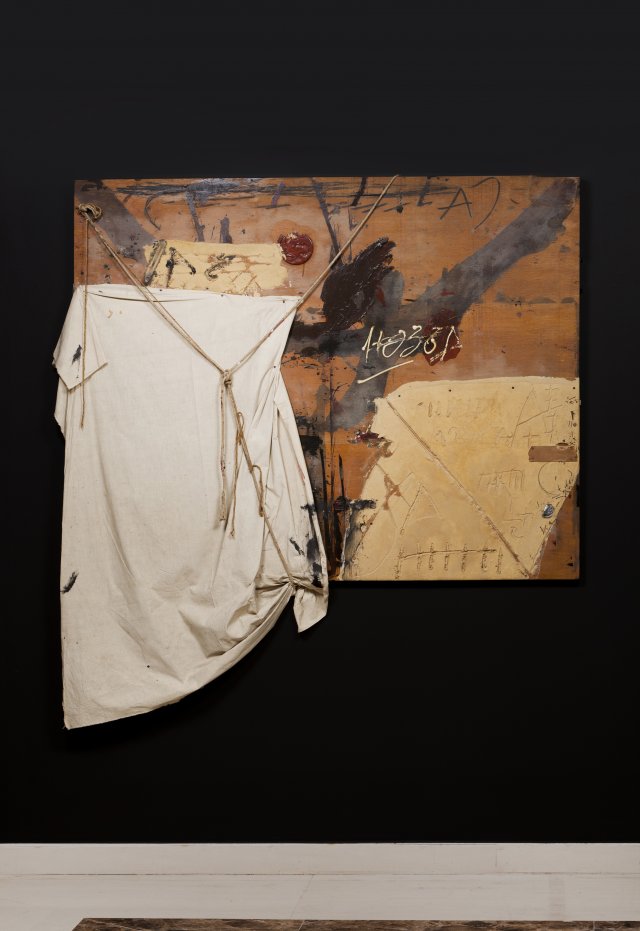25
"Composición con Ropa y Cuerda"
Antoni Tàpies (1923-2012)
Estimate
Price on request
Session
1 June 2021
Description
Mixed media on plywood
Signed and dated 75 on the reverse
145,5x162,5 cm
Category
Modern and Contemporary Art
Additional Information
Exhibitions:
"Antoni Tàpies", Seibu Museum of Art, Tokyo, Japan, 1976, nº 67;
"Antoni Tàpies: Thirty Three Years of His Painting with Cloth and Robe", Albright-Knox Art Gallery, Buffalo, USA; Museum of Contemporary Art, Chicago, USA; Marion Koogler McNay Art Institute, San Antonio, USA; Art Center, Des Moines, USA; Museé d'Art Contemporain, Montreal, Canada, 1977, Cat. p. 68, nº 81;
"Antoni Tàpies, Selected Work: 1975-1977", Martha Jackson Gallery, New York, USA, 1978, nº 14;
"Antoni Tàpies: Paintings, Drawings and Collages", Museum of Art, Fort Lauderdale, USA; New World Center, Dade Community College, Miami, USA, 1979;
"Antoni Tàpies", Seibu Gallery, Tokyo, Japan, 1988.
Literature:
"Review", in: Mizue, Nº 860, 1976, p. 101;
"Review", in: Architectural Digest, May 1985, p. 242;
Anna Agusti, "Tàpies: The Complete Works 1969-1975", Vol. III, p. 497, nº 3041.
Provenance:
Martha Jackson Gallery, New York, USA;
David Anderson Gallery, Buffalo, New York, USA;
Private Collection, Portugal.
Lot Essay by Enrique Juncosa, Writer and Curator
In the fifties and sixties, while producing the “pinturas matéricas” that made him famous, Tàpies also produced the first of a series of his own works, also radical in their approach, which, over the years, would come to form an important aspect of his work. We are talking about his assemblages, a sort of three-dimensional collages made by juxtaposing everyday objects and materials which, instead of being painted, are literally incorporated into the works. Among these works are “Composición con ropa y cuerda”, which we are discussing here, and other works, such as the early “Porta metal-lica i violín” (1956), made with the objects that give it its title, such as a garage door, on which the artist painted a large black cross, and a violin (1956); “Caixa de cartó desplegada” (1960), a painting made by unfolding a cardboard box; “Cadira i roba” (1970), a wooden chair
on which a pile of used clothes, including towels and blankets, has been placed; “Taula de desptax amb palla” (1970), an old desk covered with a pile of straw; and “Homenaje a Picasso” (1981), a public work, controversial at the time, as it resembles a pile of rubbish, permanently installed in Passeig Picasso, in Barcelona. All these works, made with poor and unusual materials, can easily be related to Italian “Arte Povera”, which burst onto the Art scene in the second half of the 1960s, or to the so-called “Combines” of the American Robert Rauschenberg, who already in the 1950s incorporated objects such as wheels, furniture or dissected animals into some of his works.
“Composición con ropa y cuerda” is made on a plywood board covered with signs, strokes made with rapid brushstrokes, thick material extensions, and stains, all suggesting chaos, improvisation, urgency, and even scatology. A cloth, the garment referred on the title, covers the left side of the work from the middle of its top. It also hangs beyond the limits of the wooden board, recalling the drapery of Renaissance and Baroque paintings. Above this cloth, to its right but still on the left side of the painting, an old rope tied together forms a large "Y". In the centre of the painting, moreover, behind the cloth and rope, we see a blackish form that vaguely suggests a head and a body, from which dark diagonal lines emerge, like the open arms of a crucifixion. These diagonals, and those formed by the tied rope, give the whole ensemble a sense of instability, uncertainty, irresolution and movement.
The materials with which the work is made, the plywood board, the cloth and the rope, being old materials with the appearance of waste, have a great evocative power, playing with our memory and our experience, and the trace of the human, in a similar way to how everyday materials are used by artists of the nineties, such as the Polish artist Mirsolaw Balka or the Colombian Doris Salcedo, researchers of personal and collective traumas. The canvas, returning to Tàpies' work, conceals what is behind it, while the rope evokes a package or wrapping, all suggesting hidden or secret meanings. The atmosphere of the work is, on the other hand, similar to that of a work in construction, as if implying that the viewer must construct or reconstruct its meaning. The rope and cloth also suggest a theatrical stage, with its backdrops and stage machinery, although the whole thing is more of a set than a tragedy. To the right of the composition, there is also graffiti that resembles a series of numbers or letters, adding mystery and inviting the possibility of interpretation. The title of this work, which as we can see seems to show and hide at the same time, is merely descriptive, ignoring all the semantic considerations mentioned, although it is well known that Tàpies was interested in mysticism and the esoteric traditions of the great religions.
Closed Auction




